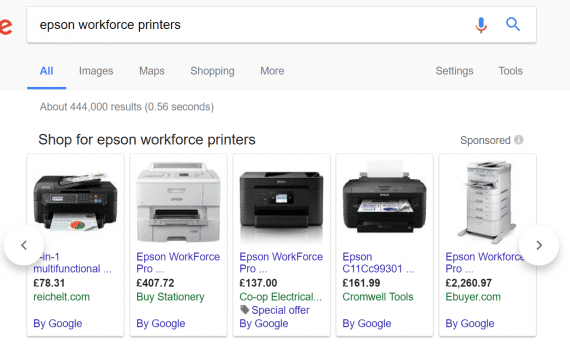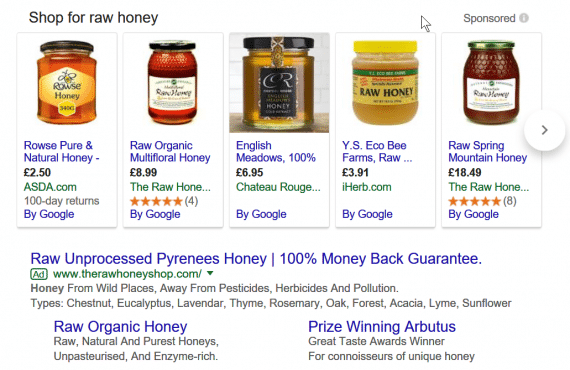Google Shopping ads appear in search results as pictures above or alongside the text-based ads and organic listings. But unlike text-based ads, Shopping ads always carry an image, price, and other descriptions.
This is the first installment in my series on using Google Shopping ads to grow your ecommerce businesses.
Shopping ads are becoming more prominent and versatile. They can appear for precise keyword searches — e.g., an exact product make and model — making them very effective in matching products to buyers.

Google Shopping ads can dominate the search results for physical products.
To use Google Shopping campaigns, you need a Google Ads account as well as a Google Merchant Center account to which you must be able to export your products from your ecommerce store.
As with Google text ads, it is free to show your ads. You only pay when a user clicks on them.
Google Shopping was first introduced in the U.S. in 2009. But unlike Google Ads, Shopping is not yet universally available worldwide. It is still rolling out into new countries.
As a result, due to little competition, click prices in these new locations can be as cheap as $0.01 (1 cent), making the sales from those ads highly profitable.
Why Google Shopping?
You can use Google Shopping campaigns alongside existing text ads or independently of them. You can serve several of your products at the same time in Shopping ads. Thus your products can occupy a significant part of the search results page, giving you maximum sales opportunities.

In this example from Google search results, The Raw Honey Shop has two Shopping ads (“Raw Organic Multifloral Honey” and “Raw Spring Mountain Honey”) as well as a text ad.
Because some highly specific product searches use relatively low volume keywords, regular text ads may not even show when Google Shopping ads do, giving your products extra visibility they may not otherwise have had.
Moreover, Shopping campaigns are an important source of keyword and negative keyword research for use in text ad campaigns and for on-page content optimization.
And, importantly, I’ve seen revenue gains of 10 – 40 percent from Google Shopping campaigns, beyond traditional text ads.
SEO
Search engine optimization is typically a long game. It can take weeks, months, or longer to see meaningful results. Shopping ads, however, can generate traffic and sales immediately.
I’ve seen well-targeted Shopping campaigns wherein 60 percent of visitors buy the product within the same hour of seeing the ad.

Well-targeted Shopping campaigns can generate sales nearly immediately — 60 percent of visitors buy the product within the same hour of seeing the ad in certain instances.
How Shopping Campaigns Work
Unlike regular Google text ads that are based on the keywords you select and ad copy you write, Google Shopping campaigns require no keywords and no ad copy.
These are created automatically from your product data, which is very strict and all-important. It can be the difference between success and failure of your campaigns.
It also means that careful product segmentation and negative keywords are a critically important way of controlling and optimizing Google Shopping campaigns from showing the wrong products for user searches.
When a user searches for a product, Google compares the search term to the signals your products carry. It then serves your ads for all that are a close match.
Every product you sell has a unique product page URL, meaning every Shopping ad click delivers the visitor to a specific product, not the home page or a product category page.
For well-optimized product data and specific searches, Google is surprisingly accurate at matching products to user searches, making Google Shopping potentially a reliable source of buyers.
Follow the Money
The key to success in Google Shopping — for all ecommerce merchants — is to track sales and profit to the penny. Many are still not doing this. Sales and profit are the most important things to monitor. Otherwise campaign management and optimization are impossible.
Fortunately, shopping carts make real-time monitoring easy.
Not every product will sell or make a profit. You can control in Google Shopping which products show ads, and focus your campaigns to be the most cost-effective.
By monitoring sales, profit, and ad cost — and thus return on ad spend — in almost real-time, you can fine-tune your campaigns for best performance by individual product.
Then, when you know your campaigns are profitable, you will be able to safely increase your budget to make more money, instead of trying to spend less.
Getting Started
Google Shopping is a strict marketplace with many features and rules. Your products could change frequently, as could pricing and stock levels. Your ecommerce store must therefore always be synchronized with your Merchant Center account. This will prevent your ads, products, and stock levels from becoming obsolete, which might result in a suspension.
But if you follow the straightforward rules and keep your products approved, Google Shopping ads can be very successful.
Not every merchant will get the same results, however. In my experience, Google Shopping works best for merchants whose products have these attributes:
- Barcodes,
- Makes and models,
- Manufacturer part numbers,
- Global Trade Item Numbers,
- Specific sizes, shapes, colors, and dimensions.
Google changes its product data specification frequently. Optional attributes can become required, and new attributes sometimes show up.